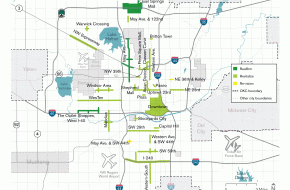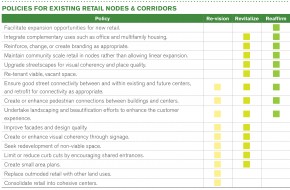Retail Nodes and Corridors
Oklahoma City seeks to develop a robust retail sector to generate the sales tax levels and growth needed to fund quality services for its residents and businesses for years to come. In addition, residents and businesses need healthy retail nodes and corridors to meet their needs for goods and services and to enhance the quality of surrounding neighborhoods. The following goals and policies are applicable to existing retail nodes and corridors within Oklahoma City. They will serve to maintain, and in many cases, revitalize important retail concentrations over the long term.
Key Land Use Goals
The following are the City’s main land use goals related to the city’s retail nodes and corridors:
- Develop Downtown as a regional retail center.
- New regional retail should be clustered in existing regional nodes, which are immediately accessible by major highway interchanges. These nodes are identified on the Land Use Typology Area map as Regional Districts.
- New community-scale retail should be concentrated in nodes rather than in a linear pattern along highway or arterial corridors.
- The oversupply of older retail space should be reduced by re-purposing space for new retail opportunities or for other uses.
Policy Frameworks
Major nodes and corridors are categorized into one of three possible policy frameworks: re-vision, revitalize, or reaffirm. These were developed to provide context and guide retail policy and implementation tools. Proposals for investment in retail nodes and corridors should receive greater weight, as these areas are critical for the health of surrounding neighborhoods and the City’s fiscal health. Investment could be in the form of infrastructure, amenities, further planning, or other technical assistance/capacity building.
- Re-vision: These nodes or corridors have significant challenges related to transportation and physical building quality and perform lowest on a sales per square foot basis. They require significant replacement of outmoded retail into other land uses to reduce the oversupply of retail space in these areas and provide additional demand for remaining retail. Based on the physical obsolescence of many of these areas, the focus should be on redevelopment.
- Revitalize: These areas generally do not require wholesale changes in uses, but rather, help strengthening existing retail uses through re-tenanting of vacant space, the elimination of retail space to “right size” the node or corridor, landscape and beautification efforts, façade programs, business coordination, and the introduction of new complementary land uses.
- Reaffirm: These nodes and corridors perform at the high end of the sales per square foot range and generally feature well-maintained retail centers and commercial property. The goal for these nodes and corridors is to maintain relevance over the long-term in an increasingly competitive retail environment. Actions to maintain and enhance performance in these areas include attracting new or “one-in-the-market” tenants, assembling under-utilized land to open up expansion opportunities, establishing land use controls to restrict further expansion of linear “strip” development along corridors, and general landscape and beautification efforts.
The table at right displays the general policies applicable to each of the frameworks described above. The table indicates what policies are most appropriate or may be most effective in areas needing either re-visioning, revitalization, or reaffirmation.
























